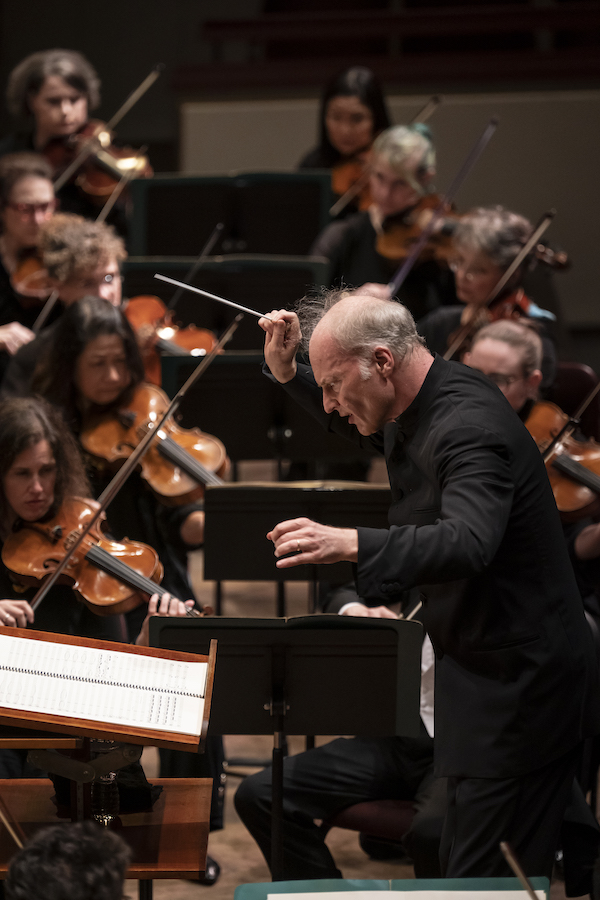Noseda and NSO wrap Beethoven cycle with a fast and furious Ninth

Gianandrea Noseda conducted the National Symphony Orchestra in Beethoven’s Symphony No. 9 Thursday night at the Kennedy Center. Photo: Scott Suchman
Gianandrea Noseda’s Beethoven cycle with the National Symphony Orchestra came to its expected conclusion Thursday night: a standing ovation preceded by a rapid, aggressive Ninth Symphony. Tickets for all three performances were all snapped up, the first time that has happened for the NSO since Stephen Hough sold out the Concert Hall in March.
The Italian conductor had a couple surprises in store for this final installment of his “Beethoven-plus” series of concerts, begun last year and spread out over two seasons. A brief curiosity opened the evening, the Overture to The Creatures of Prometheus, Beethoven’s only full-length ballet score. The ballet’s odd story, about how Prometheus gives humans not only fire but also music, art, and dance, made an intriguing lead-in for the composer’s final symphony.
It’s not much of a piece, composed as it was by a fairly young Beethoven, in 1801. The woodwind parts, taken by the non-principal players, lined up with clarity and precision. The string sections, especially the violins, did not sound quite as unified, even in relatively smaller numbers, with only about thirty players on the stage.
George Walker’s Sinfonia No. 5 (“Visions”) was perhaps the obvious choice to go with Beethoven’s Ninth, since both works incorporate text and extra-musical ideas, touching on socio-political issues. It seemed the odd man out when paired with Beethoven’s Seventh and Eighth last month. Noseda instead went with Sinfonia No. 3, from 2007, but the work’s caustic dissonance resonated with the more discordant parts of the Beethoven work in other ways.
The first movement had a lot in common with other Walker symphonies: short motifs, beginning in unison and building up clusters of dissonance. The composer’s interest fell mostly on the weaving of textures, building up masses of sound crested by waves of pounded percussion and blaring brass. In the gentler second movement, glowing strings coalesced around the plaintive oboe in a gesture that returned several times, with more clashing reminiscences of the first movement intervening.
The third movement bustled with greater rhythmic vivacity, thanks to the rattle of percussion. Metallic clangs and thumped drums evoked an almost machine-like feeling, with echoes of Stravinsky’s more barbaric scores, particularly The Rite of Spring, and some allusions to the menace of Shostakovich, perhaps even his DSCH melodic motive. If he thought of non-musical ideas in the work, Walker gave nothing away, titling the three movements soberly with plain metronome markings.
While a laudable exercise of rarely performed music by a neglected black composer, it was hard not to notice a disappointing sameness and arid quality across the five Walker symphonies. There are moments in these scores, including in Sinfonia No. 3, that are almost interchangeable with similar sounds in the others.
Noseda’s interpretation of Beethoven’s Ninth Symphony meshed with previous performances of most of the others in the cycle. The high-octane approach worked best in the first two movements. Noseda heightened the mysterious tensions of the first movement by going heavy on the brass and timpani. The crisp tempo pointed out similarities to the damnation scene in Don Giovanni, and the coda had the feel of a little funeral march.
Speed played strongest in the second movement, making it a rollicking Scherzo replete with good humor and unexpected turns. Carefully etched triplets, anchored on solid downbeats, flowed with precision, accented by timpani and brass. The NSO brought out the contrast with the Trio section, all smooth articulations and dynamic shading. The style blew the dust off more staid renditions of past decades.
The third movement never quite hit the sweet spot for its tempo indication, Molto Adagio e Cantabile. Many beautiful things happened along the way, as Noseda dug into the texture looking for unusual lines to highlight. By the time of the most complex variation, with ornate filigree lines rippling in the strings, it all went by far too fast to be appreciated, unaided by some rare flubs in the horn section.
Noseda likewise rushed through much of the piece’s epic finale, starting with the harried recitative for the cellos and basses. The piece really came to life with the entrance of bass-baritone Ryan McKinny, a late replacement for Hanno Müller-Brachmann, due to visa trouble. McKinny introduced the words of the Schiller poem known as “Ode to Joy” with prophetic bluster. Tenor Issachah Savage matched him in the military episode, with a heraldic sound that equaled the janissary fervor of the contrabassoon, piccolo, and triangle accompaniment. Both soprano Camilla Tilling and mezzo-soprano Kelley O’Connor could not quite measure up in volume, with Tilling’s upper range wanting in security against the full orchestra.
This was not a problem at all for the Washington Chorus, in large numbers seated in ranks above the stage. Their diction was unified and consummately clear, without sounding exaggerated, and the balance of voices at forte dynamics was impeccable. The only weakness came from the men in the “Seid umschlungen” section, where the tone lost its chant-like luster at the top notes. Shortcomings aside, there was much to cheer about, and that is exactly what the capacity audience did.
The program will be repeated 8 p.m. Friday and Saturday. kennedy-center.org

Photo: Scott Suchman

Posted Jun 02, 2023 at 2:08 pm by Gary Freedman
Since I was a teenager, I wanted to see a performance of the Beethoven Ninth. I wasn’t disappointed by this performance. Terrific !!